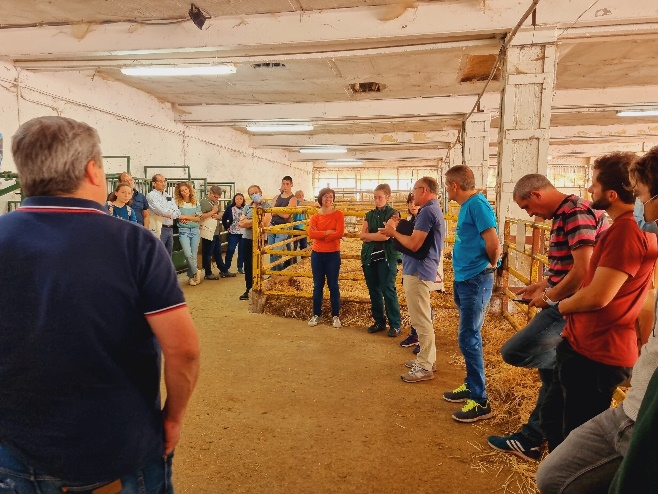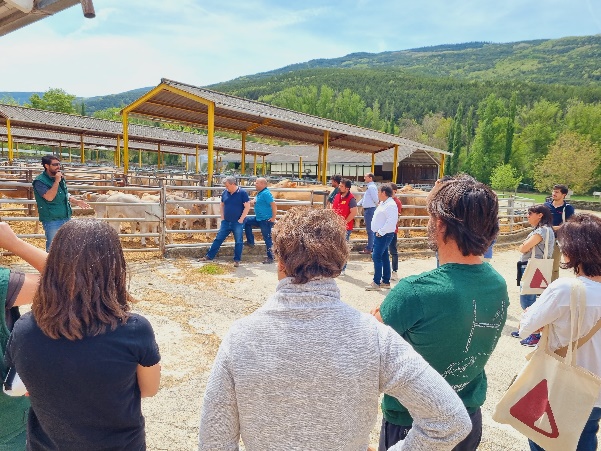Authors: Jakeline Vieira Romero (jakromero@unizar.es) and Virginia C. Resconi (resconi@unizar.es); – UNIZAR
The demo on Ovarian synchronisation was held 12th of May 2022 with a group of beef farmers, advisors, technicians, researchers and students in La Garcipollera Research Station, an experimental farm from CITA de Aragón located in Bescós de La Garcipollera (Huesca, Spain).
In the first part of the meeting, Albina Sanz an expert on animal reproduction from CITA de Aragón, presented the theme of Ovarian synchronisation protocols. In his approximately 30-minute presentation, the researcher covered various topics quite relevant, such as:
- Synchronisation requirements;
- Matting planning;
- Artificial Insemination (AI) and fixed-time AI (FTAI);
- Ovarian follicular dynamics;
- Ovarian synchronisation programmes;
- Ovsynch ovarian synchronisation protocol;
- VACAFERTILTERUEL project.

Albina Sanz's presentation was recorded (in Spanish) and is available:
Afterwards, the group was taken on a tour through the experimental farm, observing the facilities and the animals, where the participants could discuss, clarify their doubts and give their opinions on the theme. Furthermore, a written survey was collected to know their opinions.


The implementation of ovarian synchronization has been associated with several benefits, which were highlighted by the farmers and A. Sanz, such as:
- Allows the calving concentration, which facilitates labour and feed forecasting, and favours the sale of calves.
- Favours the use of FTAI (fixed-time artificial insemination), which aids in control of venereal diseases, reduces the problems with dystocia and allows the incorporation of superior genetics at a lower cost;
- Herd homogeneity;
- Increasing profitability.
Such benefits improve the reproductive efficiency of the herd and the farmer´s quality of life. However, adopting the use of ovarian synchronisation protocols could be costly, as the farmer who wishes to use FTAI should seek the advice of a technical specialist to recommend the most appropriate protocols for each type of animal and herd.
Furthermore, A. Sanz stressed that to guarantee the success of AI, some actions are necessary, such as: checking the cows' cyclicity and body condition; the quality of the semen; hygiene in all procedures; the planning of the programme, products, handling corral; the veterinarian's skill; handling the animals without stress (no dogs, shouting, etc.); not vaccinating or deworming during the following month; and making an early diagnosis of pregnancy, to resynchronise the empty females or detect the first heat after insemination with the bull.
One obstacle mentioned in the survey by a suckler farmer was the use of hormones in organic livestock, which is prohibited. Only artificial insemination after heat detection is allowed. The costs and labour availability were mentioned by other farmers.
On the other hand, the genetic improvement that can be achieved through insemination adds value to the calf, which could be sold for a higher price, increasing farm profitability. Furthermore, it is possible to plan and improve the reproductive efficiency, improving productivity and profitability of suckler cows farm.
The majority of farmers would recommend this innovation to other farmers as it could improve significantly the reproductive efficiency of the herd.
This theme is very pertinent to the region, so that the event caught the attention of the television program Tempero, which belongs to a regional channel in Spain (Aragón TV). The full interview can be seen in the link below (in Spanish) from minute 17:30 onwards:
https://alacarta.aragontelevision.es/programas/tempero/cap-677-28052022-1501
Demonstrations on Ovarian synchronisation protocols were also carried out in Germany.
Link to the innovation on BKH: https://hub.bovine-eu.net/optimizing-the-number-of-calves-per-cow-per-year-in-suckler-beef-herds-/ovarian-synchronization-protocols-to-improve-reproductive-efficiency-in-beef-heifers
Practice abstract (in Spanish): https://drive.google.com/file/d/1wIiF5flEcylLRJDu27betoywjsnXX1yb/view?usp=sharing
News on the BovINE website: https://www.bovine-eu.net/bovine-european-network-technical-conference-at-la-garcipollera-experimental-farm/
Interview for a TV channel:
https://alacarta.aragontelevision.es/programas/tempero/cap-677-28052022-1501